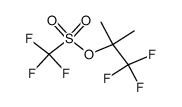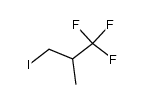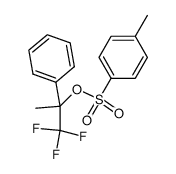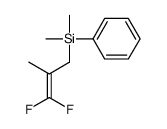374-00-5
| Name | 3,3,3-trifluoro-2-methylprop-1-ene |
|---|---|
| Synonyms |
2-methyl-3,3,3-trifluoropropene
3,3,3-trifluoro-2-methylpropene Propene,3,3,3-trifluoro-2-methyl MFCD00042093 1-Propene,3,3,3-trifluoro-2-methyl 2-(Trifluoromethyl)propene 3,3,3-Trifluor-2-methyl-propen sNpLAHJPtadTaeTp@ |
| Density | 1.039g/cm3 |
|---|---|
| Molecular Formula | C4H5F3 |
| Molecular Weight | 110.07800 |
| Exact Mass | 110.03400 |
| LogP | 2.12480 |
|
Section 1: Product Identification Chemical Name:2-Trifluoromethylpropene, min.97% (material sold in non-returnable cylinder) CAS Registry Number:374-00-5 Formula:CH3C(CF3)=CH2 EINECS Number:none Chemical Family:organofluorine compounds Synonym:3,3,3-Trifluoro-2-methyl-propene
Section 2: Composition and Information on Ingredients IngredientCAS NumberPercentACGIH (TWA)OSHA (PEL) Title Compound374-00-5100%2.5mg/m3 (as F)2.5mg/m3 (as F) Section 3: Hazards Identification Extremely flammable. Exposure to high concentrations in the atmosphere may cause drowsiness, fatigue and Emergency Overview: confusion. Primary Routes of Exposure:Ingestion, inhalation, skin, eyes. Eye Contact:May cause irritation of the eyes. Skin Contact:May cause irritation of the skin. Inhalation:May be irritating to the nose, mucous membranes and respiratory tract. Ingestion:No specific information is available on the physiological effects of ingestion. Acute Health Affects:May be irritating to skin, eyes and respiratory tract. Product contains fluorine which under certain conditions of use, decomposition, or metabolism, may generate Chronic Health Affects:fluoride ion, causing, nausea, vomiting, labored breathing, hypocalcaemia, deterioration of bone and tooth structure, kidney and liver damage. NTP:No IARC:No OSHA:No SECTION 4: First Aid Measures Immediately flush the eyes with copious amounts of water for at least 10-15 minutes. A victim may need Eye Exposure: assistance in keeping their eye lids open. Get immediate medical attention. Wash the affected area with water. Remove contaminated clothes if necessary. Seek medical assistance if Skin Exposure: irritation persists. Remove the victim to fresh air. Closely monitor the victim for signs of respiratory problems, such as difficulty Inhalation: in breathing, coughing, wheezing, or pain. In such cases seek immediate medical assistance. Seek medical attention immediately. Keep the victim calm. Give the victim water (only if conscious). Induce Ingestion: vomiting only if directed by medical personnel. SECTION 5: Fire Fighting Measures Flash Point:no data Autoignition Temperature:no data Explosion Limits:no data Extinguishing Medium:dry chemical, carbon dioxide, water fog, or foam. If this product is involved in a fire, fire fighters should be equipped with a NIOSH approved positive pressure Special Fire Fighting Procedures: self-contained breathing apparatus and full protective clothing. Hazardous Combustion andIf involved in a fire this material may emit toxic organic fumes and corrosive hydrogen fluoride. Decomposion Products: Unusual Fire or Explosion Hazards: Flammable. No unusual fire or explosion hazards SECTION 6: Accidental Release Measures Spill and Leak Procedures:The material is a gas at room temperature. If released, leave the area until the gas disperses. SECTION 7: Handling and Storage Handling and Storage:The material is stored in a cylinder. SECTION 8: Exposure Controls and Personal Protection Eye Protection:Always wear approved safety glasses when handling a chemical substance in the laboratory. Skin Protection:Wear protective gloves and clothing. Ventilation:This product should only be handled in an efficient fume hood. If ventilation is not available a respirator should be worn. The use of respirators requires a Respirator Respirator: Protection Program to be in compliance with 29 CFR 1910.134. Ventilation:This product should only be handled in an efficient fume hood. Additional Protection:No additional protection required. SECTION 9: Physical and Chemical Properties Color and Form:gas Molecular Weight:110.08 Melting Point:no data Boiling Point:6-7°C Vapor Pressure:25 psia, 20°C Specific Gravity:no data Odor:not determined Solubility in Water:insoluble SECTION 10: Stability and Reactivity Stability:air and moisture stable Hazardous Polymerization:no hazardous polymerization Conditions to Avoid:contact with ignition sources Incompatibility:active metals Decomposition Products:carbon dioxide, carbon monoxide, fluorinated by-products and organic fumes. SECTION 11: Toxicological Information RTECS Data:No information available in the RTECS files. Carcinogenic Effects:no data Mutagenic Effects:no data Tetratogenic Effects:no data SECTION 12: Ecological Information Ecological Information:No information available SECTION 13: Disposal Considerations Disposal:Dispose of according to local, state and federal regulations. SECTION 14: Transportation Shipping Name (CFR):Compressed gases, flammable, N.O.S. Hazard Class (CFR):2.1 Additional Hazard Class (CFR):NA Packaging Group (CFR):NA UN ID Number (CFR):UN# 1954 Shipping Name (IATA):Compressed gas, flammable, N.O.S. Hazard Class (IATA):2.1 Additional Hazard Class (IATA):NA Packaging Group (IATA):NA UN ID Number (IATA):UN# 1954 SECTION 15: Regulatory Information TSCA:Not listed in the TSCA inventory. SARA (Title 313):Title compound not listed. Second Ingredient:none SECTION 16 - ADDITIONAL INFORMATION N/A |
| Hazard Codes | F: Flammable; |
|---|---|
| Risk Phrases | 12 |
| Safety Phrases | 9-16-33 |
| RIDADR | UN 3161 |
| Hazard Class | 2.2 |
| HS Code | 2903399090 |
| Precursor 8 | |
|---|---|
| DownStream 1 | |
| HS Code | 2903399090 |
|---|---|
| Summary | 2903399090. brominated,fluorinated or iodinated derivatives of acyclic hydrocarbons. VAT:17.0%. Tax rebate rate:13.0%. . MFN tariff:5.5%. General tariff:30.0% |









